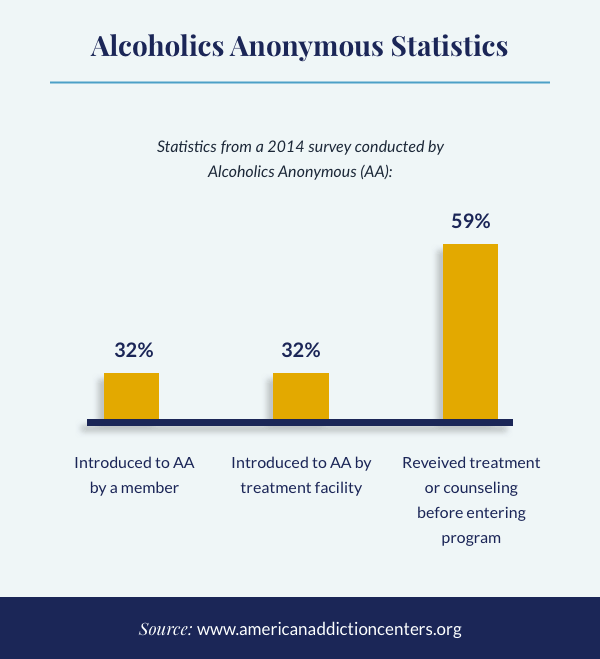Alcoholics Anonymous: The 12 Steps of AA & Success Rates
What is Alcoholics Anonymous?
Alcoholics Anonymous (AA) is an international fellowship of peer support groups for people struggling with alcohol use disorder (AUD), commonly referred to as alcoholism.
Members meet regularly to discuss issues and concerns related to their addiction and support one another through triumphs and relapses.
Generally, more seasoned group members “sponsor” newer members, guiding them through the process of “working the Steps” to help with alcohol rehabilitation.
Take Our Substance Use Self-Assessment
Take our free, 5-minute substance use self-assessment below if you think you or someone you love might be struggling with substance use. The evaluation consists of 11 yes-or-no questions that are intended to be used as an informational tool to assess the severity and probability of a substance use disorder. The test is free, confidential, and no personal information is needed to receive the result.
Does Your Insurance Cover Treatment? If the cost of rehab is preventing you from finding help, your insurance may be able to cover all or part of the cost of treatment. Find out below.
How AA Works: The 12 Steps of AA
Alcoholics Anonymous uses the 12-Step approach. Members work the Steps on their path to recovery, often with the help of a sponsor.
These are the 12 Steps of Alcoholics Anonymous:
- We admitted we were powerless over alcohol — that our lives had become unmanageable.
- Came to believe that a Power greater than ourselves could restore us to sanity.
- Made a decision to turn our will and our lives over to the care of God as we understood Him.
- Made a searching and fearless moral inventory of ourselves.
- Admitted to God, to ourselves, and to another human being the exact nature of our wrongs.
- Were entirely ready to have God remove all these defects of character.
- Humbly asked Him to remove our shortcomings.
- Made a list of all persons we had harmed, and became willing to make amends to them all.
- Made direct amends to such people wherever possible, except when to do so would injure them or others.
- Continued to take personal inventory and when we were wrong promptly admitted it.
- Sought through prayer and meditation to improve our conscious contact with God as we understood Him, praying only for knowledge of His will for us and the power to carry that out.
- Having had a spiritual awakening as the result of these Steps, we tried to carry this message to alcoholics, and to practice these principles in all our affairs.
Members can revisit the Steps at any point. Some people work them multiple times.
AA History & Statistics
The group originated in 1935 when Bill Wilson and Dr. Bob Smith formed a group in Akron, Ohio, for those suffering from alcohol use disorder (AUD).1 The concept of the group revolves around the fact that alcohol addiction is an illness that can’t be controlled but can be managed. Additionally, the group centers on spirituality and its impact on alcohol rehabilitation and recovery.2
As per the 2024 National Survey on Drug Use and Health, 46.6% of people aged 12 and older reported drinking in the past month, while 20.1% of people aged 12 and older binge drank in the past month (5 or more drinks on one occasion for men, 4 or more drinks for women). In addition, 5.7% stated they engaged in heavy alcohol use over the past month (binge drinking on 5 or more days over the past 30 days).3
In 2015, only 4.4% of people age 12 and older struggling with AUD received treatment.4

With the prevalence of alcohol addiction in the U.S. and around the world, the widespread presence of AA is not a surprise. Alcoholics Anonymous has more than 115,000 groups worldwide.5
A survey conducted by AA in 2014 showed that:5
- 32% of people were introduced to the group by another member.
- An additional 32% were introduced to AA by a treatment facility.
- 59% of AA members received some form of treatment or counseling before entering the program.
What is the Success Rate of Alcoholics Anonymous?
Success can mean different things in different contexts. Some members stay sober long-term without relapsing, while others may relapse one or more times as part of their recovery journey. Everyone’s experience is different.
There isn’t a precise success rate of AA since many of the results are published by AA and vary based on several factors. Given the anonymous nature of AA, some members of the group don’t participate in studies, since it could breach the anonymity of the group. Many want their participation in AA to remain unidentified, in line with the group’s original intention. Additionally, participants might not want to admit to relapse. This makes it difficult to calculate an exact AA success rate.
Moreover, the people who attend meetings change constantly since people drop out. In fact, 40% of people drop out of AA during the first year, according to some studies.6
Reported Alcoholics Anonymous Success Rates Vary Widely
Although AA has been criticized by some sources for having a low success rate, the rate likely isn’t 5%, as some say it is.7
- Addiction specialists cite success rates slightly higher, between 8% and 12%.7
- A New York Times article stated that AA claims that up to 75% of its members stay abstinent.8
- Alcoholics Anonymous’ Big Book touts about a 50% success rate, stating that another 25% remain sober after some relapses.9
A 2014 study conducted by AA found the following among over 6,000 members:5
- 27% of the participants were sober for less than a year.
- 24% were sober 1-5 years.
- 13% were sober 5-10 years.
- 14% were sober 10-20 years.
- 22% were sober for 20 or more years.
Long-Term Studies on the Success Rates of AA
The National Institute on Alcohol Abuse and Alcoholism (NIAA) featured results on a long-term study on AA members. The study consisted of formally treated, informally treated (AA), and untreated individuals who suffered from an alcohol problem.10
- The one-year and three-year follow-up points indicated that half of the participants who entered AA on their own were abstinent, while only a quarter of those who entered formal treatment were abstinent at the time of the follow-up.
- The eight-year follow-up showed that 46% of those who chose formal treatment were abstinent, while 49% of individuals who attended AA were abstinent.
- Results revealed that those with alcohol issues who participated in both formal treatment and AA were more likely to be abstinent than those in formal treatment between years one and three, but did not show much difference in abstinence rates after eight years. This group did not show much difference with the AA-only group across the follow-up period in terms of abstinence rates.
- The results concluded that for some, AA attendance can be a source of recovery.
Veterans Affairs Study on AA Success Rates
A study conducted by the U.S. Department of Veterans Affairs showed abstinence rates of males recovering from alcohol use disorder at 1 year and 18 months.
Only about 20-25% of those who did not attend a 12-Step program (such as AA, or another aftercare program) were still abstinent from alcohol and drugs after one year.
By contrast, the abstinence rate was nearly twice as high for those who did attend AA or another similar 12-Step facilitation program without any aftercare.
The results showed that the more meetings people attended and the longer they were in the program, the greater the chances of alcohol and drug abstinence.11
Another study from the same publication observed a smaller outpatient sample. The results found that over 70% of those who attended a 12-Step program weekly for 6 months were still abstinent from alcohol at the two-year follow-up.
Another study conducted on people with an untreated drinking problem showed that 70% of participants who spent 27 weeks or more in AA were still abstinent from alcohol at the 16-year follow-up mark. The study reinforced that those with a shorter duration of time in AA had lower rates of abstinence.11
So, Does AA Work?
Many people find that a 12-Step approach can be a valuable part of recovery, especially as ongoing support after completing addiction treatment. While AA is rooted in spiritual concepts, participants are welcome to define their own version of a higher power, whether that’s a traditional religious figure, nature, community, or something else entirely.
To be truly effective, an addiction aftercare program should meet the participant’s specific needs, and in some cases, a more secular approach to recovery may be preferable.
One key factor that influences AA’s success rate is participation. If people don’t adhere to the structure and attend regular meetings, they won’t receive the full benefit of the program, so it’s important that people are committed to meeting attendance recommendations.
Why It Matters
Understanding how and when AA works can help individuals make informed decisions about their recovery path. With so many treatment options available, knowing the factors that influence Alcoholics Anonymous’ success, like engaged participation, can empower people to choose the support system that’s most likely to help them stay sober long-term.
Finding Sobriety With American Addiction Centers
Facilities operated by American Addiction Centers (AAC) offer 12-Step group meetings as part of their treatment programs. AAC also provides other evidence-based treatment options, including:
- Behavioral therapy.
- Psychoeducation.
- Medications for substance use disorder.
- Treatment for co-occurring disorders.
If you or someone you love has an addiction to alcohol and it is affecting their lives, call (866) 957-1781 to speak to a compassionate admissions navigator.
Explore our rehab centers below.
